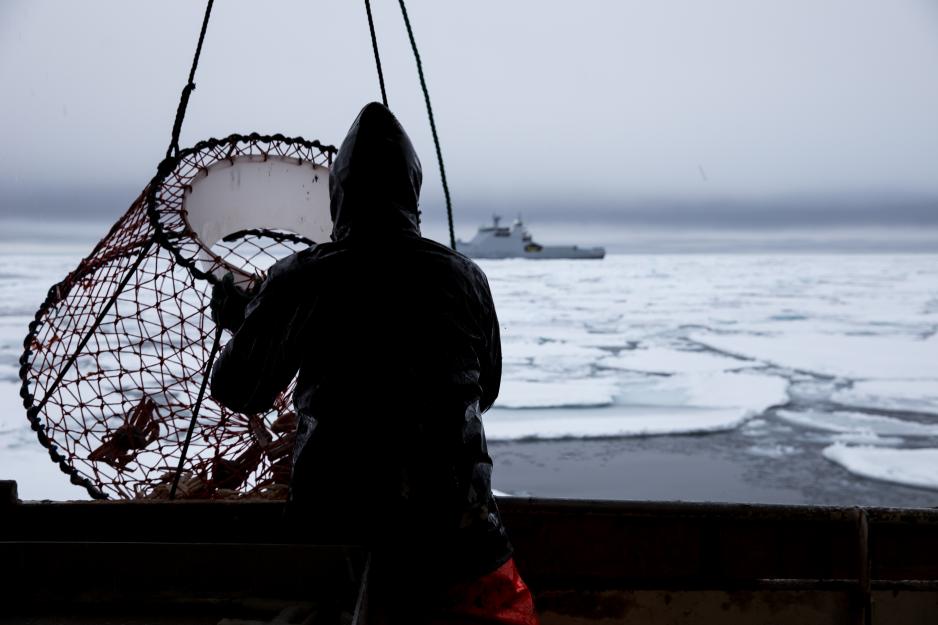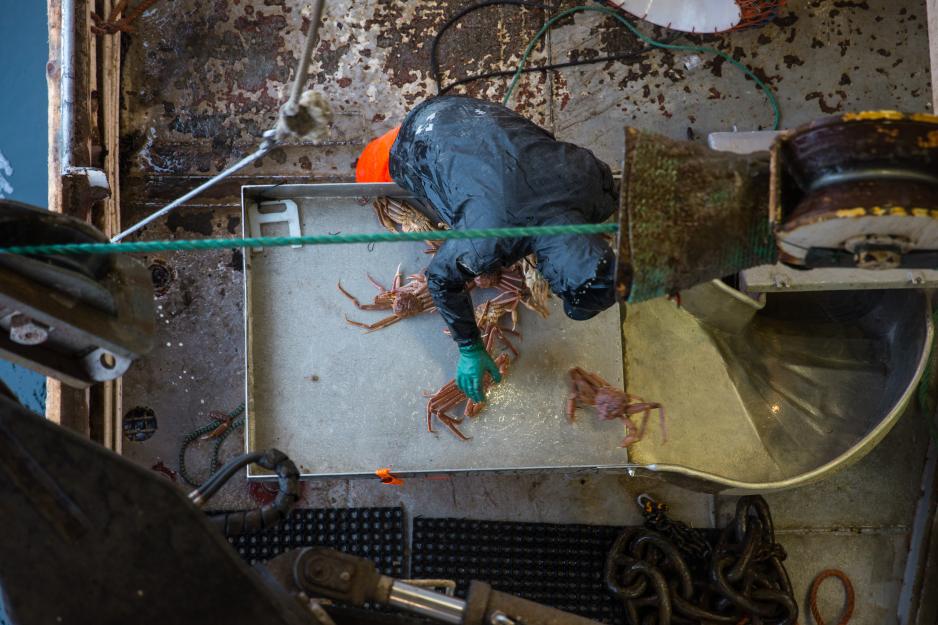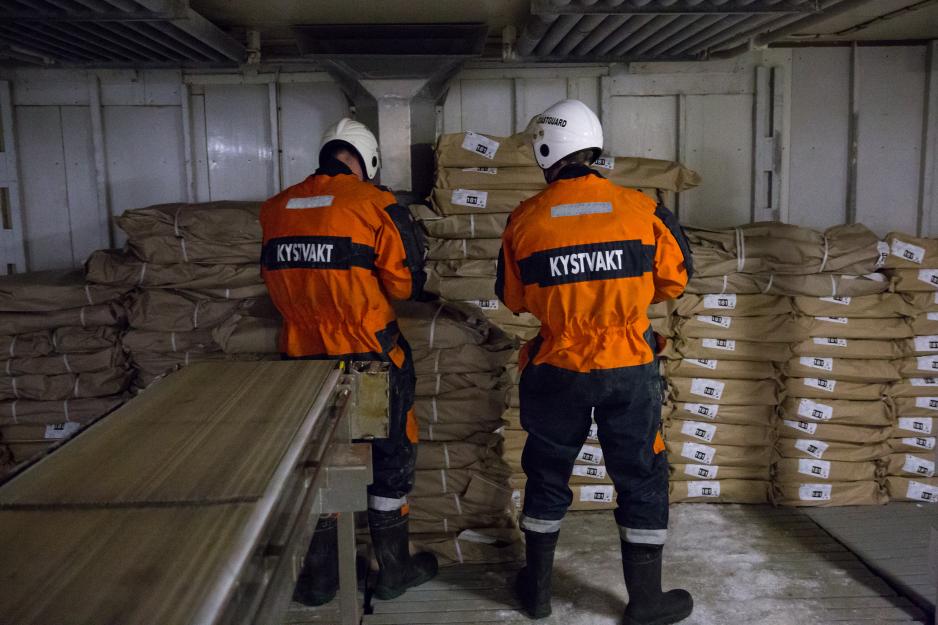Red King Crab Heading for Svalbard, Problems Line Up for Norway

It is likely that the red king crab will establish a presence around Bear Island by 2025 and Svalbard by 2030, says the Norwegian Institute of Marine Research. Picture from the Coast Guard’s inspecting a snow crab catching vessel. Photo: Norwegian Armed Forces
The red king crab is spreading out and will get to Svalbard by the end of the next decade, according to the Norwegian Institute of Marine Research. That may cause trouble for Norwegian authorities.
The troublesome, yet lucrative red king crab keeps spreading west from the Barents Sea. It currently lives as far west as Tromsø and during the next decade it will reach Svalbard, predicts Head of Research Carsten Hvingel at the IMR in a new report.
- It is quite likely that the crab will establish a presence around Bear Island by 2025 and Svalbard by 2030, Hvingel says.
At Svalbard, it would be accompanied by what is often refered to as the red king crab’s little sister, the snow crab. The snow crab, just like the red king crab, is a much sought after resource, however, that also makes it cause trouble for Norwegian authorities around Svalbard.
The snow crab dispute
The UN Convention on Law of the Seas establishes that both the red king crab as well as the snow crab are shelf species and to be regulated as such. It means that they, unlike fish that swim in the ocean, belong on the continental shelf. Whatever state owns the shelf, owns the resources on it – and through that also the crabs.
Norway argues that Svalbard does not have its own continental shelf, but that the archipelago rather lies on the Norwegian shelf. That is why the Svalbard Treaty’s section about equal rights to exploitation of the shelf around Svalbard does not apply, according to Norwegian authorities.
In February 2019, the Norwegian Supreme Court ruled that Norway is in its full right when denying EU countries the right to fish snow crab in the protected zone around Svalbard. The ruling came after the Latvian shipowners SIA North Star took Norwegian authorities to court after its vessel was prevented from catching snow crab in the protected zone some three years ago.
The EU, on the other hand, argues that Norway violates the Svalbard Treaty because there is discrimination between Norwegian and foreign vessels. In October, it was announced that the EU will continue issuing licenses for snow crab catching near Svalbard to vessels from its member states, in direct violation of the Supreme Court ruling. Norway is, so far, rather alone in arguing that Svalbard lies on the Norwegian continental shelf.
And this is where the red king crab may come crawling.
The most dramatic option would be if another state chose to take Norway to the court in the Hague

The snow crab is more common than the red king crab, however, the latter is far more exclusive on the market. Here from snow crab catching in the Barents Sea. Photo: Norwegian Armed Forces
Red King Crab
The red king crab, also known as Kamchatka crab and Russian crab, is a large-built crab species.
The species was introduced to the Murmansk Fjord by Soviet researchers in the 1960s. Since then, it has spread east and west in the southern Barents Sea, including along parts of the Norwegian coast.
The red king crab has a red tint to its shell and can grow up to 10 kilogrammes’ weight. Its body shield may measure up to 25 centimeters, however a weight of 8 kg and a body shield of maximum 23 centimeters is more common. With its claws stretched out, it can measure 2 meters end-to-end.
In Norway, the species was first caught in the Varanger Fjord in 1977, some 150 kilometers from where the Russians introduced it.
The red king crab is a valuable resource and forms the basis for extensive coastline fisheries in eastern parts of Finnmark County, Norway.
Sources: The Norwegian Institute of Marine Research, Wikipedia
Big politics
- Then there will be another resource up there that others may want to get their hands on. The red king crab may thus lead to a similar problem for Norway as the snow crab has, says Professor of Law at the University of Oslo, Geir Ulfstein.
The question about regulating crab catching around Svalbard has big political implications because the crabs are a shelf resource. They are thus regulated in the same way oil and gas are. Whatever countries agree on when it comes to crab catching may thus have bearings for future oil and gas exploitation off the archipelago in the Arctic.
- Norway will keep asserting Norwegian regulations. Now, Norwegian authorities also have a Supreme Court ruling to support them. Other states will have to take the initiative if they want the current state of affairs changed. The most dramatic option would be if another state chose to take Norway to the court in the Hague, says professor Ulfstein.
- Many countries have threatened to do so before, however, none of them have. It will be a question about whether the home state of a potential shipowner feels wronged enough to invest in the case and bring it to the Hague.
Lucrative red king crab
It remains to be seen whether catching red king crab off the coast of Svalbard will be lucrative.
- If commercial catching is to pay off, it must establish presence with a certain amount. It is hard to predict this, says Head of Research Carsten Hvingel at the Norwegian Institute of Marine Research.
Today, catching of red king crab in the Barents Sea amounts to less than half the amounts of snow crab caught there. There is simply more snow crab and it is spread out across a bigger area.
- On the other hand, the red king crab is more lucrative; the price per kilo of red king crab is four times the amount given for snow crab for the fishermen, says Hvingel.
The red king crab originates from the northern Pacific Ocean but was introduced to the Murmansk Fjord by Soviet scientists in 1961. Since then, it has spread both east and westwards in the Barents Sea and to the coast of Finnmark and Troms counties in Norway. There has been commercial catching of red king crab in Norwegian waters since 2002.
- Initially, Norway has committed to trying to prevent spreading of species that have been artificially introduced, such as the red king crab. However, whether or not that is at all possible is a major question. The red king crab has become part of our ecosystem and established a solid presence, says Alf Håkon Hoel, Professor at the Norwegian School of Fisheries at the University of Tromsø.
He does not believe the red king crab will lead to more trouble for the Norwegian authorities if it establishes a presence around Svalbard.
- I cannot see that a potential spreading of red king crab further north would lead to new problems. The Supreme Court ruling is rather unequivocal Hoel says.
Carsten Hvingel has calculated that the red king crab will spread as far south as to Trøndelag in central Norway.
- I assume it will arrive there in some thirty years, by 2050. Further south, the ocean will be too warm for the red king crab, says the scientist.
I cannot see that a potential spreading of red king crab further north would lead to new problems.

One of the Norwegian Coast Guard’s most important tasks is inspecting fisheries in the Norwegian protected zone. Photo: The Armed Forces
This article was originally published in Norwegian and has been translated by HNN's Elisabeth Bergquist.
